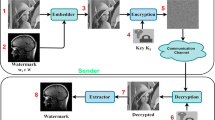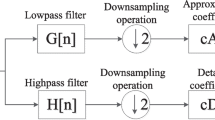Abstract
In order to achieve the integrity authentication of speech files, a hash-based dual fragile watermarking algorithm is proposed. In the proposed scheme, a host speech signal is firstly transformed into a matrix, then each row and column of the matrix and a sensitive hash function (MD5) are used to generate two fragile watermarks. In the process of tamper detection, extracted watermarks and reconstructed watermarks are applied to construct two verification vectors, which form a verification grid that helps to detect attacks, locate the forgery domain and determine the type of modifications. Experimental results show that the watermarking scheme has good imperceptibility and fragility. More importantly, the proposed algorithm can not only detect attacks, but also accurately locate the tamped samples, and even identify the type of counterfeits.















Similar content being viewed by others
References
Chen OTC, Liu CH (2007) Content-dependent watermarking scheme in compressed speech with identifying manner and location of attacks. IEEE Trans Audio Speech Lang Process 15(5):1605–1616
Chen F, He H, Wang H (2008) A fragile watermarking scheme for audio detection and recovery. Processing of 2008 Congress on Image and Signal (CISP 2008). pp. 135–138
Huiping G, Yingjiu L, Anyi L, Sushil J (2006) A fragile watermarking scheme for detecting malicious modifications of database relations. Inform Sci 176(10):1350–1378
Juan L, Rangding W, Diqun Y, Youming L (2014) A multipurpose audio aggregation watermarking based on multistage vector quantization. Multimedia Tools Appl 68(3):571–593
Kais K, Abdel-Ouahab B (2013) Audio watermarking via EMD. IEEE Trans Audio Speech Lang Process 21(3):675–680
Korus P, Dziech A (2014) Adaptive self-embedding scheme with controlled reconstruction performance. IEEE Trans n Inf Forensic Secur 9(2):169–181
Lei B, Soon IY, Tan EL (2013) Robust SVD-based audio watermarking scheme with differential evolution optimization. IEEE Trans Audio Speech Lang Process 21(11):2368–2378
Lei B, Soon IY, Li Z (2011) Blind and robust audio watermarking scheme based on SVD–DCT. Signal Process 91(8):1973–1984
Liu Z, Wang H (2014) A novel speech content authentication algorithm based on bessel-fourier moments. Digit Signal Process 24:197–208
Liu Z, Wang H (2014) Pseudo-Zernike moments-based audio content authentication algorithm robust against feature-analysed substitution attack. Multimedia Tools Appl 70(3):2271–2291
Mingquan F, Hongxia W, Hengjian L (2014) A fingerprint-based audio authentication scheme using frequency domain statistical characteristic. Multimedia Tools Appl 70(3):2255–2270
Nematollahi MA, AI-Haddad SAR (2013) An overview of digital speech watermarking. Int J Speech Technol 16(4):471–488
Qin C, Chang C-C, Chen P-Y (2012) Self-embedding fragile watermarking with restoration capability based on adaptive bit allocation mechanism. Signal Process 92(4):1137–1150
R. Rivest (1992) The MD5 message-digest algorithm. RFC 1321
Tong X, Yang L, Zhang M, Chen Y (2013) A novel chaos-based fragile watermarking for image tampering detection and self-recovery. Signal Process Image Commun 28(3):301–308
Tsougenis ED, Papakostas GA, Koulouriotis DE, Tourassis VD (2012) Performance evaluation of moment-based watermarking methods: a review. J Syst Softw 85(8):1864–1884
Wang H, Fan M (2010) Centroid-based semi-fragile audio watermarking in hybrid domain. Sci China Inf Sci 53(3):619–633
Wang X, Wang P, Zhang P (2013) A norm-space, adaptive, and blind audio watermarking algorithm by discrete wavelet transform. Signal Process 93(4):913–922
Xinpeng Zhang, Shuozhong Wang, Guorui Fen (2009) Fragile watermarking scheme with extensive content restoration capability. Proceeding of the 8th International Workshop on Digital Watermark (IWDW 2009), pp. 268–278
Acknowledgments
This work is supported in part by the National Natural Science Foundation of China (NSFC) under the grant No. 61170226, 61170175.
Author information
Authors and Affiliations
Corresponding author
Rights and permissions
About this article
Cite this article
Qian, Q., Wang, HX., Hu, Y. et al. A dual fragile watermarking scheme for speech authentication. Multimed Tools Appl 75, 13431–13450 (2016). https://doi.org/10.1007/s11042-015-2801-4
Received:
Revised:
Accepted:
Published:
Issue Date:
DOI: https://doi.org/10.1007/s11042-015-2801-4




